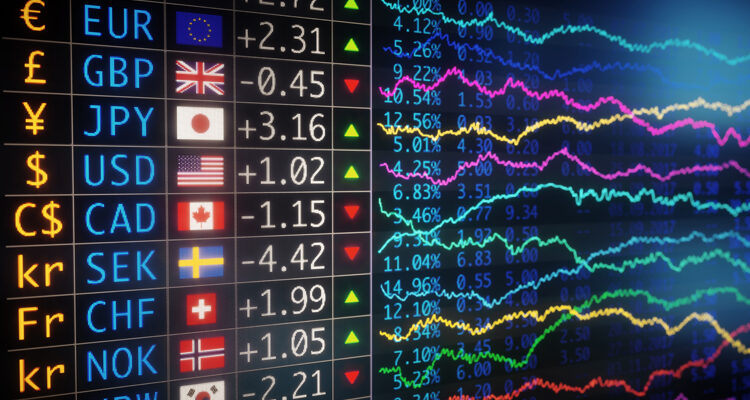
2022 was undoubtedly the year of the dollar. Although the U.S. currency has recently retreated from its October peak, the USD index still gained 8% in 2022 (see chart).
The main question in the foreign exchange (FX) markets today is whether this latest dollar down move is simply a technical correction due to the market’s reassessment of the future speed of U.S. interest rate hikes, or a true inversion of the trend (i.e., is the USD rally over?).
The consensus forecast is that the United States will suffer a recession in 2023. If we follow the same logic that saw the dollar soar in 2022, this should lead to lower U.S. interest rates and a lower USD. However, it is useful to identify potential variables that could point to a different outcome. First, the recession is expected to be relatively mild. Second, when we talk about currencies, “it takes two to tango.” A foreign exchange rate is the price of one currency expressed in another currency. Therefore, it is important to understand what is happening in the rest of the world and how it is going to impact the FX markets.
According to the International Monetary Fund, one-third of the world economy will be in recession this year. In particular, the three biggest economies – the U.S., Europe, and China – are expected to slow down in 2023. If we add Canada and Mexico, we cover over half of the U.S. trade flows. Let’s take a quick look at them.
China
There is already talk in the market about “Peak China” in 2023, as, for the first time in 40 years, the country might grow at a lower rate than the world economy, saddled by low population growth, a weak real estate market, a heavy debt burden, a surge in COVID infections and above all, sluggish export growth. Given this outlook, it is likely that the Chinese government will let the yuan depreciate at a faster rate than last year to prop up exports (after an 8% depreciation in 2022). If that scenario materializes, USD/CNY could reach last year’s highs and trend toward 7.50 yuan per U.S. dollar.
Europe
After 2 years of continuous weakness against the dollar (depreciating by 22% at its low compared to January 2021), the euro regained some ground in Q4 2022. However, the European economy is expected to be heavily impacted by the energy crisis and enter recession mode this winter. This has led the European Commission to forecast an apathetic growth of only 0.3% for the year ahead. Let’s also keep in mind that the European Central Bank has consistently lagged the Federal Reserve in monetary policy and will also likely hit the brakes on new hikes sooner than the Fed. This does not bode well for the euro. The European currency could resume its downtrend against the dollar and trade below parity again (1 EUR = 1 USD).
Canada
Out of the main G7 currencies, the Canadian dollar has profited the least from the latest USD weakness (clawing back only 25% of the ground lost in the year to October versus the euro at 66%, for example). With a ratio of trade-to-GDP above 60% (versus the U.S.’ 25%), an open economy like Canada is bound to be hit particularly hard by the global economic slowdown, which could weaken the Canadian currency again down to 1.38 or even 1.40 against the U.S. dollar.
Mexico
The Mexican peso, on the other hand, has been markedly stable in 2022, as the Bank of Mexico has firmly replicated the Fed’s monetary policy (i.e., hiking rates in unison with the Fed). With a trade-to-GDP ratio even higher than Canada, Mexico is a very open economy, and therefore the peso could suffer from the projected global economic slowdown, pushing the currency well beyond 20 pesos per dollar.
As the famous quote says, “the trend is my friend” and until very recently, the trend has been a strong dollar. However, there are many variables that impact currencies, and the market generally reacts to unexpected events. A deeper U.S. recession (forcing the Fed to cut rates much faster and sooner than anticipated), an early resolution of the Ukraine crisis (boosting the euro across the board), or a resilient Chinese economy are some of the events that could lead to a true inversion of the trend.
What is certain is that FX volatility is back. U.S. exporters and importers, as well as investors in foreign markets, will probably be looking at their FX exposure to decide how and when to hedge their foreign exchange risk.
About the Author – JC Fernandez-Seoane
JC Fernandez-Seoane is WSFS Director of Foreign Exchange. His main goal at WSFS is to design and deliver foreign exchange risk management solutions to the Bank’s Clients. JC has always worked for international banks in the foreign exchange and financial derivatives markets, first in Europe (London, Paris and Madrid), and later in New York City.
JC received a master’s degree in international economics from Sciences-Po in Paris, an Executive MBA from London Business School in the UK, and a master’s degree in Extension Studies from Harvard University.



